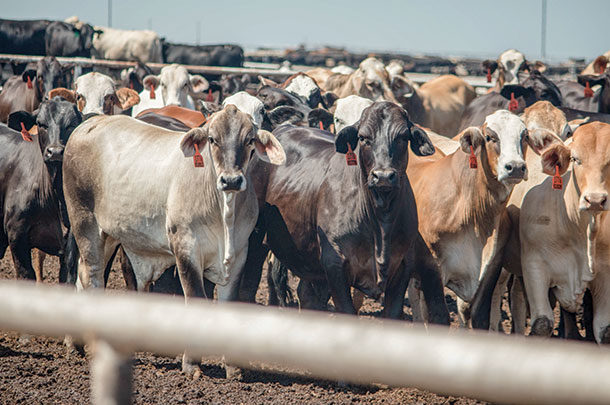Cull cow market reaches potential
The cull cow market is slowly rising as producers begin to cull their herds again after holding back cows and growing their herds due to the drought in 2014. Patrick Linnelle, an analyst at CattleFax said, “We expect to see [more culling] continue as the beef cow herd expansion comes to a flattening point.”
For dairy cows in the cull market, cull numbers remain up as dairy farmers face depressed milk prices, and increased culling is expected to continue until milk prices rise again, according to Linnelle. Beef producers reaching a comfortable herd size and dairymen culling due to milk prices leads analysts to believe 2019 will follow 2018’s trend with a higher-than-normal cull market.
The total amount of cows in the U.S. has rebounded from the 2014 low and is expected to stabilize in the 41 million to 42 million head range, which is approximately where it was in the early 2000s, according to Linnelle.
Slaughter cow market faces ebbs and flows
Since 2014, some slaughter plants have closed in the Midwest and South, in states such as Mississippi and Texas. This has caused a decrease in slaughter capacity and even though a plant opened in Idaho, other plants will have to add second shifts to keep up with the flow of cattle, according to Linnelle.
This leaves a group of states mostly unserved by slaughter plants such as Missouri, southeastern Kansas and Tennessee. Eastern Montana and other Northern states such as the Dakotas are facing lacking slaughter capacity, and producers are paying to haul cattle elsewhere.
According to CattleFax analyst Troy Bockelmann, the restricted slaughter capacity means any increase in cattle needing to be harvested will have to be done in the first quarter of the year. According to Bockelmann, any other time will push plants past a 40-hour work week.
To make matters more difficult, winter weather could “push fed cattle back” and delay their slaughter in the first quarter. This ripple effect could continue throughout the year.
With this scenario, beef prices would likely be supported due to the constant cattle flow, but the cattle’s slaughter being delayed risks volatility with plants having to work 40-plus- hour weeks in the summer and fall.
What this means for producers
Cull cow values differ during the year, and the ability of processing plants to keep up with supply are just a few things a producer should consider.
After calves are weaned, underperforming cows are sent to the auction house. This depresses prices in the fourth quarter of the year while there is a rising demand in the spring and summer.
“Instead of selling cows and calves into that fall run where the market is overrun by cows and calves, sell into the April-May-June time frame where they’re both high demand and tight supply,” Linelle said.
Producers are still recommended to remain flexible in their culling and avoid selling at peak times to get the best prices.
“As we think about the seasonality of this market and how reliable it tends to be, this is one where flexibility certainly could pay some dividends,” Linnelle said. “As we look back across history, we tend to see that eight out of 10 years perform the same seasonal pattern.”
Linnelle proposed a producer shifting part of the cow herd to a fall-calving program.
“If you’re looking to expand, maybe you can expand into that area,” Linnelle said.
Another proposed option is weaning early and selling cows before the market becomes saturated in the fall. Feeding pairs through the winter is another option to boost cow prices at the market, but Linnelle acknowledged a few impracticalities of this scenario.
“In a lot of regions in the country, Mother Nature will be harder, but Mother Market will tend to be nicer.”
There are several options to get the best price at the market, and the theme is to sell when the market needs cattle.
Import and export markets update
Following the market closure in the early 2000s due to BSE (bovine spongiform encephalopathy), “we have seen [export] growth continue,” Bockelmann said.
The years 2016-18 all had more than 10 percent export growth rates. Growth is cyclical, and expected export growth is 6 percent in 2019.
The Asian markets are growing in demand. Exports to South Korea are up 40 percent, and Japan is up about 10 percent.
“We are continuing to see growth in beef exports but just at a slower rate than we have the last couple of years,” Bockelmann said.
Beef imports are slowly and steadily decreasing. In 2019, experts expect beef production in Australia to be down nearly 6 percent due to drought. This means less beef will be imported from Australia this year, and Mexico is holding steady on their per-capita consumption. This means less beef will be imported from Mexico.
The entire import and export market can be summed up with this way:
“The bottom line is, when we come down to it, with [the U.S.] 300,000-head increase in slaughter, a 6 percent increase in beef exports and a 4 percent decrease in beef imports, per capita, supplies are going to be relatively flat in 2019,” Bockelmann said.
Hay production looks up
This time last year much of the U.S. was experiencing a drought, and the country has mostly recovered save the West Coast.
“A lot of the hay-growing region has received adequate and above-average moisture,” Bockelmann said. “We do see hay production increasing in 2019, which will pressure hay prices down a little bit.”
The average price last year was around $160 per ton, so producers can expect a $10-12 reduction in hay prices per ton in 2019. ![]()
PHOTO: Even with higher slaughter in the forecast, the trade picture portends that supplies will be flat in 2019. Staff photo.
Lillian Kent is a senior studying animal science and agricultural communications at Texas A&M University.










